-
Posts
1,986 -
Joined
-
Last visited
-
Days Won
183
Content Type
Profiles
Forums
Downloads
Gallery
Posts posted by drjdpowell
-
-
But we're still back to the same fundamental point: why do you really want to check for such "equivalence"? I know and understand that some people "clearly want to" as you point out but that does beg the question IMO. Isn't there at least one better way to architect so that checking for such equivalence isn't needed?
I can’t say I’ve ever actually wanted to check for equivalence. But I understand not having the time to re-architecture things. In a past career I ran multi-day experiments at a nuclear physics accelerator, and the failure to get equipment working on time could lead to many months delay and tens of thousands of taxpayer dollars wasted. I have fixed high-vacuum system leaks at 4AM with fast curing epoxy, which is very much NOT the “best" way of repairing vacuum leaks, but it’s the only way to do it NOW. It’s a backup plan. It’s a HACK.
Having no ability to fix a problem in a LVOOP program except a time-consuming re-architecture, no ability to “hack” it, certainly has some strong advantages. No ability to pile hack on hack. But you also have no ability to hack it when don’t have any other option but to hack it! It’s like working without a safety net.
— James
-
We put the classes together with priority on the operations we thought people were going to need regularly. Exact type equivalence is nearly anathema to good design, as MJE noted in his original post on this topic. Yes, we could create a prim to do exact type equivalence. But the question is, why are you creating any hierarchy where the child class cannot fully substitute for the parent class? That usually leads to serious problems and hacks piling onto hacks. So we spent time on other stuff. :-)
This made me think of this past conversation of yours as an example of where having an extra type-checking primitive would be useful. Though, I see Daklu already made the same points in that conversation. You may have reason not to like a check for exact equivalence, but clearly people do have reason for some types of checks. And, remember this conversation? People have been using the object primitives that are available to substitute for operations that aren’t, and this leads to overly complex and unclear code.
-
... but the whole point IMHO is to specifically NOT exposed that, not make someone have to know the intricacies of optimizing for particular compilers, specific memory management, etc, etc because the G language handles that part of the "indoor plumbing" in a sane, predictable way...
That’s my point. The “zero iteration loop” is producing results that depend on intricacies of the complier, which are not intuitive extensions of G. I agree with MJE in expecting my example to output the default object of the wire type, but we’re both wrong. Since as AQ said, the default behavior is to return the default object *as if the loop had iterated once* he would I guess expect the “Error Report Message” (the thing returned if the loop iterated once) but he’d be wrong also. The actual answer is “Temp Update Message”, an object would never be produced by the loop on any iteration.
-
Not a trick. Just seeing if anyone can read code based on this. Sometimes it is important to understand the esoterics of what the compiler is doing, in order to work with it in producing the most optimized code. But this is really esoteric, for something that seems like it should be trivial. From looking at the below image from NI.com I would naively say that determining if two objects are the same class should be trivially easy and blindingly fast on RT or desktop systems because we just compare the two type pointers. Why is there no primitive to do this?
P.S. Anyone else care to guess what object comes out of the zero-iteration loop?
-
-
Now, if you're on a desktop system, the MJE, as I described above, does really well. I am guessing that this one would do even better:
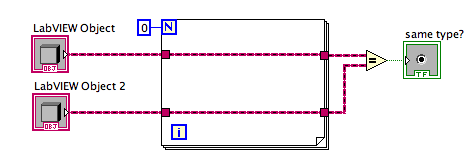
Yes, that's a hardcoded zero iteration For Loop with the class wires wired across using tunnels, not shift registers. It does the job. I haven't benchmarked it -- you're free to do so -- but it avoids the type comparison work entirely that the Preserve Run-Time Class primitive does.
If you’ll forgive me… Why does that work?!? With no loop iterations the code can’t pass the objects across and must output default values. OK, but the default value of a LabVIEW Object wire is a LabVIEW Object; how does the child class identity get passed across the void when the actual child-class objects do not? That doesn’t seem right at all.
Another issue: aren’t all these object manipulating techniques rather obtuse code? Sort of LabVIEW alchemy? The uninitiated will be mystified as to why we are “preserving run-time class” or finding the path to a class in order to tell if A and B are the same type, let alone understand a zero-iteration loop.
— James
-
 1
1
-
-
Uploading a few pictures would be helpful, such as a a screenshot of the old code and of one of your new accessors (complete with property-node update of the front panel). Otherwise I only have a vague impression of what your dealing with, though the technical term for your old code is "Big Ball of Mud". I worry that in attempting to tame the BBoM, your in danger of just adding a new layer of mud. On the other hand, you might successfully end up in a situation where new code can have much improved architecture, interfacing to the BBoM only through your "db" object.
Some thoughts:
1) the biggest speed issue is your property nodes, which are inherently slow. Don't put property nodes inside your In-Place-Element structures as other IPEs will be blocked while the property node is executing.
2) (1) is not a huge issue, as once you successfully weave "db" though the BBoM you can immediately go further is separating the UI from the logic by eliminating the direct update of FP controls from db's methods, and instead have a separate "UI loop" that periodically queries db and updates the UI. For example, if part of the code updates a state variable 1000 times a second, that would cause 1000 property-node updates/sec (which is a problem), but the UI loop could query db and update the control terminal directly 5 times per second.
3) at step (2), you can take the time to modernize your UI, since it is no longer tied one-to-one with program state variables. You could use all sorts of clever ways to present information. This could be a major improvement that you can show to your boss as payoff for your code upgrade.
4) You might have a speed issue with the DVR access (as only one IPE structure can act at any one time). I believe DVRs are very, very fast, but you are going to use it a very, very large number of times a second. And every access locks up every state variable. You could consider an alternate structure for "db": instead of a DVR of "db" that holds all the state variables, have db hold a set of DVRs of clusters of related state variables (i.e., all the "Camera" variables would be in one DVR). Then, any method of db only has to lock up the part of the state data that it is dealing with, and unrelated methods can operate in parallel. Even better would be if you could separate db into several objects corresponding to subsystems, but as you say the BBoM may not allow that.
-- James
will it be copied to sub vis even if I use DVR?
No, only the 32/64-bit DVR reference will ever be copied.
Is the access to it fast as the access to a tdms/binary file or slow and serial like a text file?Way faster than either; it's a memory access, faster than any file access.
Will it remember past values and eventually make the app bigger????
What should I watch out of while using it: rename/typedef...) and will the esf protect me from race conditions without slowing my code or even freeze it completely by pausing a code that is needed for the code with access to the db to finish for example or even some hidden issues with reentrant vis or something more devious.What's an "esf"? The issue with the DVR is that only one thing can access it at once, so you can't do anything slow inside an IPE structure without blocking other code. That requirement can conflict with the need to prevent race conditions by doing things inside the IPE. An issue you have is that you are putting the entire program's state variables in one DVR, so unrelated parts of the code will block each other without reason.
-
However, in order to decide what is a separate class, like a camera, inside an old project with >1000 vis I'll need a year of designing. It will be unrealistic since the time it takes both to create a new design and to go down and understand why the old code was implemented the way it was is not something most companies will consciously do.
Just trying to separate one class out of a non OO design without a proper design of the entire architecture is a door open for bugs and endless redesign.
Is the old code really that badly designed? Any reasonable code should have some level of separation between components; OO Classes just allow that separation to be more complete and clear. I'm just suggesting what is mostly a cut-and-paste job: identify the variables related to the camera, drag-copy them into a "Camera" class control; find a bit of code that initializes the camera, cut and paste it into an "Init" method. Don't redesign the details, just get the applications components cleanly separated, so that in future you can do things like use a different type of camera, or test the camera separately, or improve the camera code without introducing bugs in unrelated components.
To use some jargon, what I'm talking about is "Abstraction Layers".
-- James
-
 1
1
-
-
Finally!!! A reply!!!
 Thanks!!!
Thanks!!! 
Your initial post is a bit of a scattergun blast of concepts, patterns and acronyms, which, though all somewhat familiar to me, are not directly translatable into specific LabVIEW code in my head. And you didn't include any pictures! That, combined with the holidays, is why your not getting any responses.
Anyway, I'll give it a go.
The image I'm getting is of a past LabVIEW application written with the Front-Panel controls/indicators serving as the data-space ("state", "model") of the system. Perhaps with lots of local variables and Value property nodes. Your trying to partially automate the conversion of the data-space into a single "Model" object that maps onto the existing controls/indicators (there being dozens and dozens of such).
Personally, this is not how I would approach such a old program. I would instead look at how to upgrade the program part-by-part, bottom up, looking for natural encapsulation. For example, if the application uses a Camera, say, I would try and replace all the variables related to the camera with a single "Camera" class. I would try to get as much of the logic related to the camera in method VIs of the Camera class, and try to limit the number of actual "accessors" to the internal Camera data. When the "Camera" upgrade is working, I would look for some other subsystem that can be encapsulated in a class. This should slowly, step-by-step, lead to a simplification of the top-level program logic until the point that I could consider a rewrite of the application as a whole. This might contain a "Model" object, but it would itself be made up of a small number of component objects like "Camera", rather than be a huge sprawling "everything from the old program including the kitchen sink".
-- James
-
Just an idea; as I said, I have never used it yet.
FYI from a couple of months later: I have now made use of "outer envelopes". They were very useful in the writing of TCP Messengers for my message-sending reuse framework, allowing the sent messages to be packaged inside outer envelopes carrying labels that mean something to the "Client" and "Connection" actors that run the TCP communication. Using the outer envelope label obviated the need for any parsing or inspecting of a message to determine what to do with it, and led to clearer code. For example, the "Client" receives envelopes labelled "Send Via TCP", while replies to messages, to be routed back through the TCP connection, are received by the "Connection" actor in envelopes labelled "Route Back Message".
Note: all use of these outer envelopes is internal to the TCP messaging structure, and are completely transparent to the processes at each end of the connection, which do not need to do any marking of messages themselves.
-- James
Part of "TCP Client Actor" where messages to be sent through TCP are received inside "outer envelopes" marked "Send Via TCP" (the marking is done by the "RemoteTCPMessenger" class to which the messages are initially "sent").
-
I'm wondering though if the FG pattern is indeed as robust as it appears, especially for large-scale applications. Are there any known issues with the FG pattern (eg. memory leaks, lost data, crashes, etc) when used with large amounts of data stored in the USRs or operated for long periods of time?
My concern about the robustness of FGs is based on my impression that, although it works well, the pattern seems like an unintended use for a while or for loop (ie running the loop once just to read the current value of previously set USRs).
Regarding the initial post:
John, you don't have to worry about the robustness of using an uninitiallized shift register. Even if this use of a USR was not originally foreseen, it has been a common method of LabVIEW programing for many years, as are other design patterns using shift registers. However, you should carefully consider what Norm said about the possibility of eventually needing more than one copy of the thing you program as a functional global.
-- James
-
Can you get your hands on one example unit now? Learn the tuning procedure manually and then you might be able to code a simple step-by-step procedure (tune V1 until X is true, tune V2 until Y is minimized, etc.).
-
What is your question? If it is the line drawn back from (10 8) back to (0 7) that you don't want, then adding an extra point with a Y value of "NaN" (Not a Number) between them will eliminate the line.
-
By coincidence I'm working on a similar thing right now: Message objects via TCP. Like you, I've mostly done two VIs on the same machine (except for one brief proof-of-principle test between England and California which worked fine). The one issue I can add is the rather large size of flattened objects, especially objects that contain other objects (which might contain even more objects). Sending a simple "Hello World" as one of my Message objects flattens to an embarrassing 75 bytes, while the "SendTimeString" message in my linked post (which has a complex 7-object reply address) flattens to 547 bytes! I've just started using the ZLIB string compression (OpenG ZIP Tools) and that seems to be a help with the larger objects (compresses the 547 bytes down to 199). I've also made a custom flattening of the more common objects to get the size down ("Hello World" becomes 17 bytes).
-- James
-
Well, I can't say that was fun, but I've managed get my code in such a way that only required parts of it will load. I found that I had a few VIs here and there that existed to help use diverse classes together. I had placed these helper VIs inside one of the classes involved; because of this they served as linkers that caused all the classes to load when the first one did, even if that VI and those other classes were never used. Just dropping an instance of my parent class loaded 75% the entire toolkit! Tracking these Vis down and getting them out of the classes broke the cross links. I found a use for a few LVLib libraries to hold collections of these VIs and others that didn't need to be in their related classes (and didn't always need to be loaded with the class).
-
As Jarrod confirmed, the attribute operations always generate a copy. I'll refer to an old idea exchange post of mine which I would still love to see implemented though.
Kudoed. I was going to make the same suggestion if you hadn't already. Don't see why it wouldn't work with objects, though.
If you do this, just be sure your array is relatively static. Otherwise be aware any time you hope to gain via associative look-ups can easily be lost by having to operate on the array: reallocation of the entire data space as the array size changes, frameshifting the array when removing elements, etc. Basically you need to weigh the cost of manipulating the entire array when the size of the data set changes versus the cost of copying single elements.Unless your array barely ever changes, I think you'd be better off with the plain old variant and living with a single copy on each operation. DVRs might help, but keep in mind the synchronization overhead involved with the DVR isn't necessarily free so I wouldn't bother with them unless you can prove to yourself your data copies are costing you.
My array is relatively static (rare additions, no deletions), but perhaps I'll live with the copies for now, until I get to the point that I can do comparative testing.
-
Thanks, I was worried that copies are made. I was considering storing an index to an array and Tim suggests, but I might wait till I upgrade (still on 8.6) and go with the DVR as the code would be simpler.
-
Hello,
I've been using the feature of Variant Attributes to store and lookup values in an efficient way. In particular, I've been storing complex objects such as the (simplified) example below where I post messages to "Observers" of those messages.
My question is: is this the most efficient way to do this? In particular, I select one attribute, modify it, and then return it to the variant: does this involve copying the entire cluster of objects, or does the LabVIEW compiler identify this as an operation that can be done "in place"?
-- James
-
Thanks everyone, I think I'm slowly getting a better feel for how to structure things. Mostly by keeping classes out of LVLibraries, but identifying small groups that need to be closely tied together. I actually have a small section of my messaging code that uses Command-Pattern messages; if I don't put them in a Library I could accidentally build an exe that wouldn't contain its own commands! I might retain a library for the core classes that will always be needed; though the boundary of such a core isn't very distinct, so perhaps not.
I also like Paul's idea of a set of classes as one template. I don't (yet) have any such groupings, but I'm toying with the idea of a Command-Pattern-style Actor Template (ripping off inspired by the Actor Framework) and that would involve a template of multiple classes.
Part of what motivated my question is that I am currently in the middle of trying to adapt my messaging system, up to this point working only within a single Application instance, to work via TCP between different App instances or over the network. Thus, I've had to consider the issue of different instances having limited subsets of the messaging package (particularly if one instance is on a memory-limited Real Time system). A whole new dimension to worry over...
Thanks again,
-- James
-
I have a largish set of reuse code for inter-process messaging that I've been using in all my new projects. But I realize that I haven't really thought about how to organize things in Libraries. Given the difficulty in reorganizing libraries once they are referenced by many different projects, I'd like to get a good organization decided now. Currently, I have one large library with many classes in it, but that leads to any project using any part of the library loading every single class in it (and lots of VIs), even if individual projects only use a small subset of the classes. Classes that aren't in the library only load if needed, which seem a better feature. This makes me wonder if I shouldn't keep Classes in Libraries at all, unless they are very closely connected such that they will always be used together.
What do other people do in organizing with Classes and Libraries?
-- James
-
I've been meaning for the longest time to add a Network-messaging capability to this library, and finally made the time to do it this week. I thought I would update my example here with TCP communication. Converting the example took only a few minutes, which shows the advantage of the "plug-and-play" nature of using a LVOOP class structure for message communication methods.
Here's good old "Process A", now standing alone in its own App instance (Application 2), with the new "TCPMessenger" plugged in in place of the original QueueMessenger:
And here is the rest of the example on Application 1 (haven't had a chance to test on a separate computer yet). It uses "RemoteTCPMessenger" to connect to the server created internally by Process A's "TCPMessenger". Otherwise it is identical to before.
Note how the reply from Process A is routed back through the Process A's TCP connection. This is because the "reply address" on the "SendTimeString" message, "CommandMessenger B", is a QueueMessenger, and its internal queue is local, and not valid on the remote Application 2 that contains Process A. The two TCP connection "Actors", running in the background, inspect and alter the reply addresses of sent messages to perform this routing of replies through the sending TCP connection. As the "Observer Registration" messages, shown in Parallel Process, utilize the same "reply address", that system of publishing information also works via a TCP connection, even if the observer has a local-only messenger.
Here is a Message custom probe showing summary information about the message received by Process A. The "X"s after the QueueMessenger (queue refnum 4076863496), which is Process B's, and the Message Logger indicates they are invalid in Application 2 (but they are still valid in Application 1). QueueMessenger (refnum 4091543557) leads to the TCP Connection Actor.
The TCP communication is all run by "actors" based on the Parallel Process design. Creating "TCPMessenger" launches a "TCP Listener Actor" in the background. "RemoteTCPMessenger" launches a "TCP Client Actor" which initiates the connection; the TCP Listener then launches a "TCP Connection Actor" to handle its side of the connection. Multiple RemoteTCPMessengers can connect to the same TCPMessenger server (a new TCP Connection Actor is launched to serve each new connection).
-- James
-
Then moved to an alternate approach that involved using F-keys to trigger an event structure (key up) in the dialog rather than the controls. We were able to queue up multiple events with this approach which led to the screen being dismissed on subsequent sequences.
Wait, wait, wait.. I thought the dialog was a simple while loop with two buttons; where'd this event structure come from? If you have an event structure in a dialog you have to be careful to clear any leftover events, otherwise those extra key presses or clicks will be queued up and ready to go the next time the dialog runs. I think the only way to go is to dynamically register for any events you want, and unregister as you exit the dialog. Re-registering on the next call to the dialog will ensure there are no leftover events from last time. Never use statically-registered events in a dialog, as they can't be cleared.
-
I found this conversation which illustrates that event registrations seem to behave strangely and not like other refnum objects as I understand them. Something is going on under the LabVIEW hood that might be affected be a subVI, and perhaps I would be better to restrict event registrations to the same block diagram as their corresponding event structure
-
If you connect that reference to more than one event structure, you're going to get undefined (=weird) behavior, such as events being processed by multiple event structures or by none at all, without any predictability.
I learned that through painful experience. But I don't understand the relation to subVI's.
What Norm was saying is that you can't necessarily trust that if you put the R4EN in a subVI that you will get a separate reference each time the VI runs. Maybe you would, but without testing it thoroughly you can't be sure. This is made much worse if you take the reference and save it, because then you increase the risk of using it with more than one event structure, a danger which doesn't exist if the R4EN is wired directly to the structure.I understand that if the subVI returns a previously created and saved reference, then it will be the same each time. But if the subVI creates a new event registration, then it should be different each time. And both these are independent of the subVI being "inlined".
Here is an example. Since I did this two days ago, and it is the first time I've put an event reg in a subVI, it is an important case for me!
Is there something I should be worried about with this code? It's my understanding that this subVI should always create a new event registration for each call.
-- James



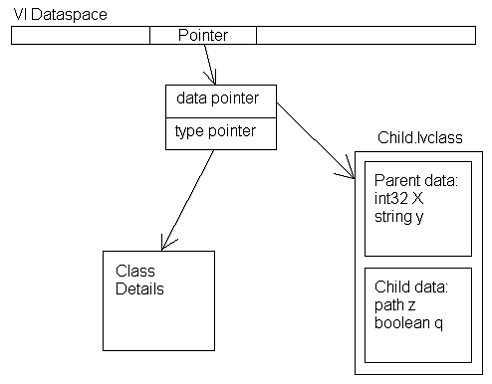
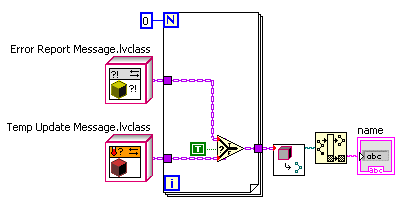
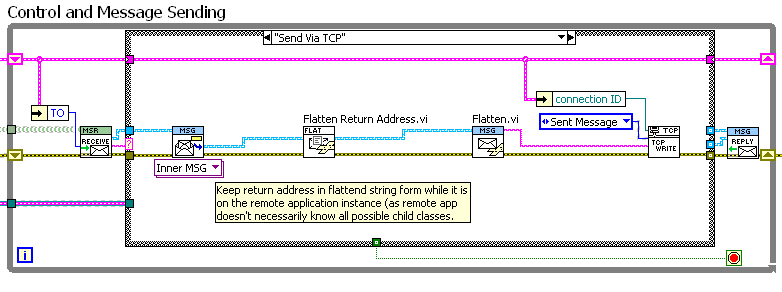

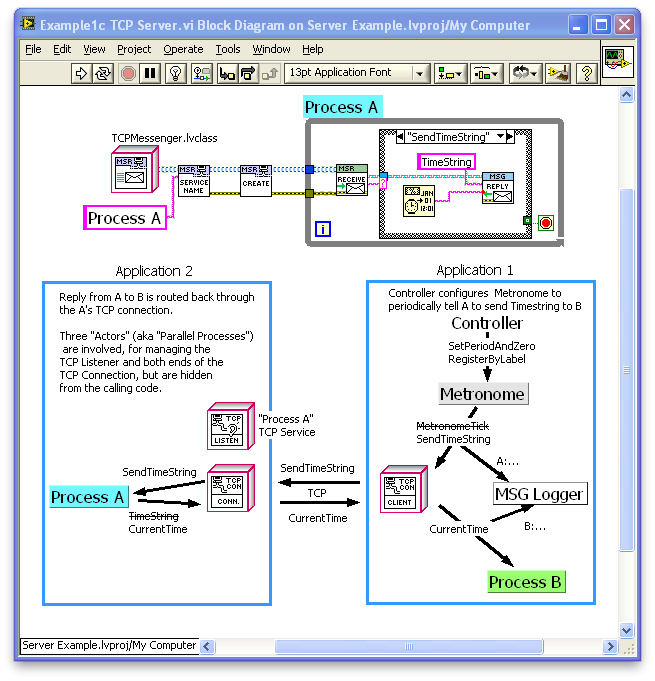
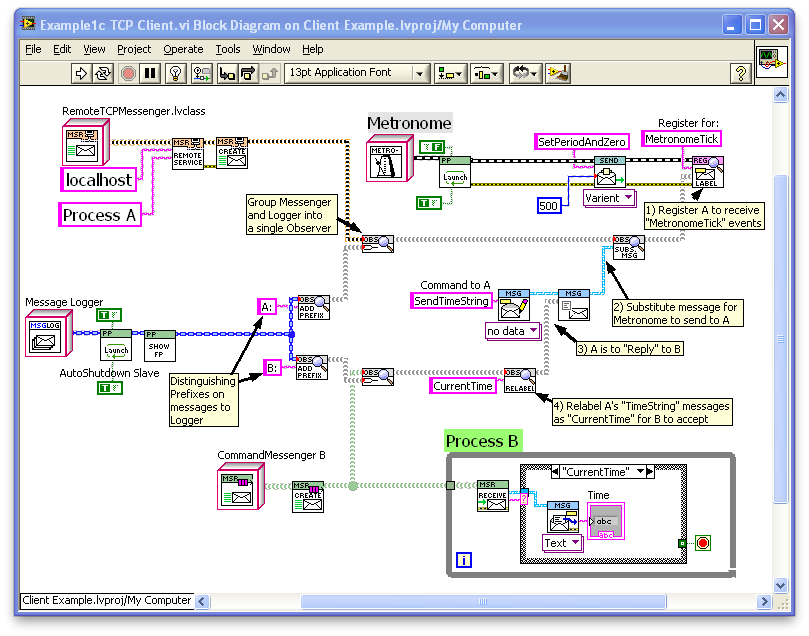
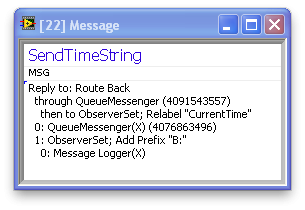
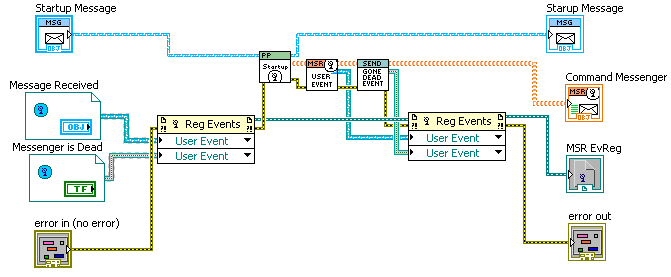
Testing for the same class
in Object-Oriented Programming
Posted
Interestingly, I also was working on serializing my message classes recently, and, though it didn’t involve testing for equivalence exactly, it was a bit “ugly” in that way, so perhaps its a good example to show (as I might be doing it all wrong). It’s sort of a hack between using the default LabVIEW flattening of objects, and custom flattening with dynamic dispatch.
The only problem I had with the default LabVIEW flattening of my Message objects is size; a simple “Hello World” message is 75 bytes. I wanted to reduce the size of at least my most commonly sent messages. Yet I didn’t want to have to commit to creating Flatten and Unflatten override VIs for every single child message class ever created. I certainly didn’t want to create two extra VIs for every Command-Pattern Style message. I wanted to do a little bit of targeted custom flattening, where it would do me the most good.
One way of making the flattened messages smaller is to use an index to identify the object class, rather than the much longer regular flat format. So the classes with custom flattening do this. But, children of these classes, which don’t have custom overrides, must include a normally-flattened object. That means that there must be some mechanism for the parent “Flatten Data.vi”, called on the child object, to be able to identify that it is not the parent object and thus needs a modified flattened form.
That might be too unclear, but I think that is in the same "anathema to good design” vein as MJE’s quick fix. Here is a picture of the code of the “Flatten Data” vi of the Message class, and overrides for two other classes that are custom-flattened: VariantMessage and OuterEnvelope (a message inside another message).
As I said, it isn’t pretty. It basically strips out the internal data of the three selected message types, flattening it in custom form, then tests to see if the remnant object is actually of one of those three types and not a child. If it does turn out to be a child, the remnant object is flattened by the normal LabVIEW function. Because I’ve just removed all the data, I can use a straight search function from an array of default objects, but otherwise this is the same as using a type equivalence comparison just as MJE has done.
Except I’m not doing this as a quick hack; I can’t think of a better way to do it. What am I doing wrong?
What am I doing wrong?
— James